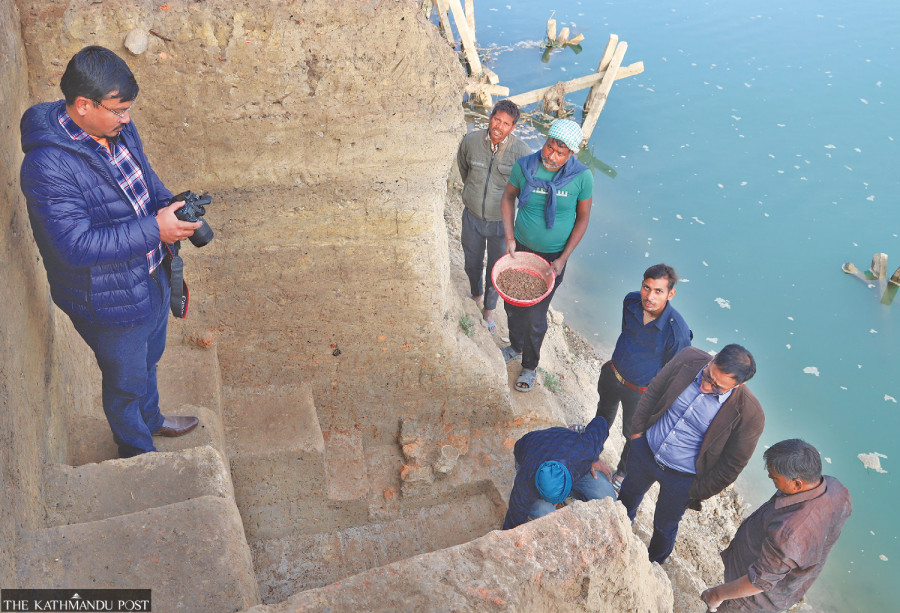National
More possible Buddha-era objects unearthed
Archaeologists undertook excavations in Nipaniya and Banharaji areas of Rupandehi recently.
Manoj Poudel
Excavations in the Nipaniya and Banjarahi areas of Rupandehi district have unearthed more fragments of northern black polished ware, the ceramics used around 700-200 BCE in the Indian subcontinent, while grey wares were also found scattered around.
A team of six archaeologists from the Lumbini Development Trust started excavating the two areas a few weeks ago following the discovery of pottery fragments and bricks of historical and archaeological importance on a wall along the bank of the Danab river.
The ruins along the river suggest the presence of human settlements in the area during or even before the Buddha era, say archaeologists and historians highlighting the need to conserve the area and protect it from river erosion.
There was a 15-day rescue excavation in Nipaniya of ward 12 of Lumbini Sanskritik Municipality in order to salvage historical ruins at risk of being swept away by the river, said archaeologists. Such excavation is done to rescue artefacts, environmental remains and plans of structures in a site which is in danger of being destroyed.
The excavation of the wall along the riverbank revealed several potsherds and brick pieces.
The archaeologists had dug up a 3.2-metre-deep trench on the river banks and excavated a structure that looked like an ancient well. A total of 19 well rings—many intact and a few broken—and many potsherds of northern black polished wares were rescued. “There are other rings below the river’s water level. They could not be extracted,” said Himal Uprety, chief of the archaeology branch of the Lumbini Development Trust.
The recovered items have been kept in a museum in Lumbini.
According to the locals, they had come across such artefacts in the area in the past as well and claim that many artefacts were swept away by the Danab river during the past monsoon seasons.
Nipaniya and Banjarahi villages are around 50 metres from each other. The two villages are in turn around eight kilometres southeast of Lumbini, the bird place of Siddhartha Gautam who later became Buddha.
According to the locals, the Danab river sometimes in the past changed its course toward the west and started eroding the banks causing damage to the ruins.
“The historical objects found in Nipaniya and Banjarahi suggest the presence of well-organised ancient human settlements around Lumbini during the Buddha period. But we cannot confirm it unless a scientific excavation is conducted in the area,” said senior archaeologist Basanta Bidari. According to him, the potsherds seem to have been from the 6th century BCE. “But detailed scientific studies and research are needed to establish the facts.”

Debala Mitra, a noted Indian historian and archaeologist, explored the Nipaniya area near the Danab river in 1962. Her team recovered potsherds of the northern black polished wares on the river bank and in the agricultural field. In her report, Mitra said that the potsherds could be from the 6th century BCE.
Likewise, Indian archaeologist SB Deo had conducted an excavation in Banjarahi in 1964. He published a book entitled ‘Archeological Investigation in the Nepal Tarai’ in 1968. In the book, he said the shreds of utensils he recovered there could be as old as the 7th century BCE.
Today both the Nipaniya and Banjarahi areas are at high risk of river erosion. The locals who have witnessed the erosion of the river banks and agricultural lands over the past decades say that the authorities have paid no heed to their warnings about losing historical artefacts to the river.
Dilip Srivastav, a local, said, “Until a couple of decades ago, we could see ruins of houses, temples, shreds of kitchen utensils, boxes, and wells in the area before the river started eroding the banks.”
The villagers also claim to have seen human skeletons in the area. “A big box was recovered in the area around 10 years ago. It was too big to lift. It was swept away by the monsoon floodwaters in the river the same year,” said Hari Mohan Chaudhary, a teacher at a local school.
Buddhist monks and educationists express their concerns about the authorities’ indifference to the preservation of a possible historical area and the remains of what could be unrecorded human settlements that could offer an insight into the history of the area.
“There could have been human settlements during the Buddha era in Nipaniya and Banjarahi as all the ancient civilisations developed on river banks. But the government has failed to preserve such an important place,” said Sumangalo, a Buddhist monk in Lumbini. “A scientific study and excavation should be carried out soon for the preservation of history for posterity.”
According to archaeologist Uprety, the well rings rescued from the Nipaniya are similar to the rings from the Harappan civilisation located in the Indus River Valley. Its two large cities, Harappa and Mohenjo-daro, were located in present-day Pakistan’s Punjab and Sindh provinces, respectively. “The Danab river has swept away around 100 metres of land along its banks and destroyed eight similar wells in the past,” he said.
Sanuraja Shakya, member-secretary of the Lumbini Development Trust, said the trust took initiatives for the conservation of the historical as well as archaeologically significant objects found in the Nipaniya area although the recovery work does not fall under its jurisdiction.
“Though it is not under the trust’s jurisdiction, we will try to recover the items before more of them are swept away. Embankments should be constructed immediately to protect these archaeologically significant sites,” said Shakya.




 16.16°C Kathmandu
16.16°C Kathmandu













